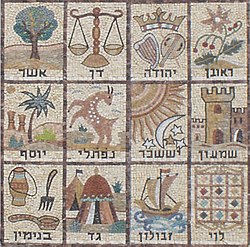
Back Twaalf Stamme van Israel Afrikaans أسباط بني إسرائيل الاثني عشر Arabic ܫܒܛܐ ܕܐܝܣܪܐܝܠ ARC بنى اسرائيل ARZ İsrailin on iki qəbiləsi Azerbaijani Ізраільскія плямёны Byelorussian Дванайсетте израилски племена Bulgarian ইস্রায়েলের দ্বাদশ বংশ Bengali/Bangla Daouzek meuriad Israel Breton Tribus d'Israel Catalan

*Asher: a tree
*Dan: Scales of justice
*Judah: Kinnor, cithara and crown, symbolising King David
*Reuben: Mandrake (Genesis 30:14)
*Joseph: Palm tree and sheaves of wheat, symbolizing his time in Egypt
*Naphtali: gazelle (Genesis 49:21)
*Issachar: Sun, moon and stars (1 Chronicles 12:32)
*Simeon: towers and walls of the city of Shechem
*Benjamin: jug, ladle and fork
*Gad: tents, symbolizing their itinerancy as cattle-herders
*Zebulun: ship, due to their bordering the Sea of Galilee and Mediterranean
*Levi: Priestly breastplate, symbolizing the Kohanim
The Twelve Tribes of Israel (Hebrew: שִׁבְטֵי־יִשְׂרָאֵל, romanized: Šīḇṭēy Yīsrāʾēl, lit. 'Staffs of Israel') are, according to Hebrew scriptures, the descendants of the biblical patriarch Jacob (also known as Israel), who collectively form the Israelite nation. The tribes were through his twelve sons through his wives, Leah and Rachel, and his concubines, Bilhah and Zilpah. In post modern scholarship, there is skepticism as to whether there ever were twelve Israelite tribes, with the use of the number 12 thought more likely to signify a symbolic tradition as part of a national founding myth,[1] although most scholars disagree with this opinion.[2]
- ^ Cite error: The named reference
Glassmanwas invoked but never defined (see the help page). - ^ Blum, Erhard (2020). "The Israelite Tribal System: Literary Fiction or Social Reality?". In Krause, Joachim J.; Sergi, Omer; Weingart, Kristin (eds.). Saul, Benjamin, and the Emergence of Monarchy in Israel: Biblical and Archaeological Perspectives. SBL Press. p. 213. ISBN 978-0-88414-451-9.